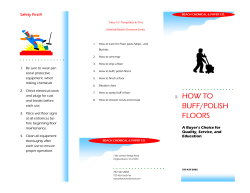
Paul Anain, MD, FACS, RPVI Vascular & Endovascular Center of WNY Medical Director of Vascular Service Line, Catholic Health
Paul Anain, MD, FACS, RPVI Vascular & Endovascular Center of WNY Medical Director of Vascular Service Line, Catholic Health Major Manifestations of Arterial Disease • Ischemic stroke • Transient ischemic attack • Myocardial infarction • Angina pectoris (stable, unstable) • Peripheral arterial disease • Critical limb ischemia, rest pain, gangrene, necrosis Risk Profile of PAD • The REACH (REduction of Atherothrombosis for Continued Health) Registry studied 7,013 patients with symptomatic PAD Key Finding 63% of PAD patients had polyvascular* disease Polyvascular disease = 63% CVD CAD 14.2% 39.4% 9.5% PAD * PAD patients with polyvascular disease had concomitant symptomatic cerebrovascular or cardiovascular disease or both. Bhatt DL, et al. American College of Cardiology Scientific Session. March 8, 2005. Presentation Asymptomatic Cerebral Vascular Accident Transient Ischemic Attack Rupture Claudication Rest pain Gangrene/Tissue loss Relative 5-Year Mortality Rates 100 86 80 Patients 60 (%) 40 20 39 32 18 23 8 0 Prostate Hodgkin's Cancer* Disease* Breast Cancer* PAD † *American Cancer Society. Cancer Facts and Figures, 2000. †Criqui MH et al. N Engl J Med. 1992;326:381-6. Colorectal Lung Cancer* Cancer* Medical Management Best Medical Treatment for arterial disease: Antiplatelets • Plavix • Aspirin Anticoagulants Statins Diet/exercise/weight loss SMOKING Cessation Medical management of HTN and DM LT2924151 Rev. B 5/9/2014 6 Anatomy and Pathology AAA — Working Definition Pathologic, focal dilatation of the aorta > 1.5X “normal” diameter Normal aortic diameter: 20-mm (range, 14-30 mm) (M > F) Increases with age Fusiform Saccular Anatomy and Pathology Demographics Prevalence: 5-7% in > 65 years old 2000 US Census 2.7 million Americans 15,000 deaths from aneurysm rupture per year 10th leading cause of death in US Americans with AAA are under‐diagnosed & under‐treated The prevalence of AAA is 4.5% in men and 1.0% in women (data from SAVE screenings) • AAA increases in frequency after 6th decade ‾ 5% of men over 65 years ‾ 10% of men over 75 1,152,294 Americans living with AAA 15% are diagnosed 6% are treated Risk Factors Risk Factors for AAA Age: > 65 years Gender: M > F (4:1) Family history (1° male relatives): 20% Smoking: > 10 pack-years Peripheral aneurysms femoral, popliteal, thoracic Hypertension Absence of diabetes Race: Caucasian > African-American AAA‐Concomitant Disease • Unselected screened patients 3.2% • Selected patients with CAD 5.0% • Selected patients with PVD 10.0% • With femoral/popliteal aneurysm 50.0% Clinical Presentation and Diagnosis Abdominal Ultrasound Safe, non-invasive Widely available Rapid Inexpensive Normal Accurate (> 90%) longitudinal axial Clinical Presentation and Diagnosis CT Scan Gold standard: Timed-bolus, intravenous contrast-enhanced, thin-cut, spiral technique Advantages • Rapid (16 / 64 multi-row detector arrays, 15-30 sec, single breath-hold) • < 1-mm spatial resolution, 3-D reconstructions • Usually operator-independent • Accurate: sizing, anatomy (dimensional / conformational) Disadvantages • Radiation • Contrast nephropathy Natural History Natural History Natural history of AAA: To EXPAND and RUPTURE > 80% of small aneurysms grow Pattern of growth is unpredictable and staccato (i.e., stop-and-go) Past growth does NOT predict future growth 50% die from other causes (mostly cardiovascular) 50% die from aneurysm rupture Natural History Risk of Rupture Estimated risk of rupture (per year) 4.0-5.4 cm 5.5-6.4 cm 6.5-6.9 cm 7.0-7.9 cm ≥8.0 cm 0.6% 10% 19% 35% 51% Risk of Rupture Rate of Expansion Estimated rate of expansion (per year) < 4 cm 4-5 cm > 5 cm 0.2-0.4 cm 0.2-0.5 cm 0.3-0.7 cm Aneurysm Size AAA‐Recommended Management • • • • 3‐4 cm follow‐up one year 4‐5 cm follow‐up six months > 5 cm‐ repair Rapidly expanding >2mm per 6 months Normal rate of expansion 2mm/year Endovascular Repair Thoracic Endograft Popliteal Aneurysm Endovascular Repair Functional Description of Intermittent Claudication • Symptoms – Exertional aching pain, cramping, tightness, fatigue – Occur in muscle groups, not joints (buttocks, hips, legs, calves) – Are reproducible from one day to the next on similar terrain – Resolve completely with 2-5 minutes of rest Prevalence of PAD/Intermittent Claudication in Smokers • Severity of PAD increases with number of cigarettes smoked • Diagnosis is made a decade earlier • Intermittent claudication is 3 times more common in smokers • Smoking is the most powerful modifiable risk factor for PAD TASC Working Group. J Vasc Surg. 2000;31(1 suppl):S1-S296. Kannel WB et al. J Am Geriatr Soc. 1985;33:13-8. How to Perform and Calculate the ABI PARTNERS Program ABI Interpretation Right Arm Pressure: Above 0.90 — Normal Left Arm Pressure: 0.71‐0.90 — Mild Obstruction 0.41‐0.70 — Moderate Obstruction 0.00‐0.40 — Severe Obstruction Pressure: PT DP Pressure: PT DP Right ABI Left ABI Higher Right Ankle Pressure = Higher Arm Pressure mm Hg Example mm Hg = = ____ Higher Ankle Pressure Higher Brachial Pressure Higher Left Ankle Pressure = Higher Arm Pressure mm Hg 92 mm Hg = mm Hg 164 = 0.56 mm Hg = ____ = See ABI Chart PAD Disease Management Symptomatic Treatment Prevention of Ischemic Events Exercise1 Smoking cessation1,2 Pharmacologic therapy – Clopidogrel5 – Cilostazol3 • Selective use of interventional therapy4 • Control of risk factors4 – Smoking – Hyperlipidemia – Hypertension – Diabetes • Antiplatelet therapy2 • • • 1. McDermott MM, McCarthy W. Surg Clin North Am. 1995;75:581‐591. 2. Clagett GP, Krupski WC. Chest. 1995;108 (4 suppl):431S‐443S. 3. Pletal (cilostazol) Prescribing Information. 4. Kempczinski RF, Bernhard VM. In: Rutherford RB, ed. Vascular Surgery. 1989: chap 53. 5. Plavix (Clopidogrel) prescribing information. Risk‐Factor Modification • Smoking cessation • LDL cholesterol <100 mg/dL, recent literature < 70 mg/dl • Glycosylated hemoglobin <7.0% • Blood pressure <130/85 mm Hg Hiatt WR. N Engl J Med. 2001;344:1608‐1621. Surgical and Endovascular Treatment Options • Surgical – endarterectomy – bypass • Endovascular – percutaneous transluminal angioplasty – percutaneous transluminal angioplasty with stent placement Creager M. Management of Peripheral Arterial Disease. Medical, Surgical and Interventional Aspects. 2000. Indication for surgical intervention Clinical Limb ischemia Gangrene Non‐healing ulcers Ischemic rest pain Claudication causing life style deterioration refractory to pharmacologic intervention and behavioral modification Right Iliac Stenosis Pre- and Post-PTA SFA Angioplasty and Stent Peripheral Arterial Disease • • • • 80 y.o. Hypertension High Cholesterol 2 week history of progressive toe pain Total Occlusion The PAD Guideline is Intended to Guide Lifelong Primary to Specialty PAD Care Population at risk: (Age and risk factors) Establish the PAD diagnosis Population with symptoms: Improve limb outcomes Prevent CV ischemic events Population remains at risk: Primary care management of legs and life, in collaboration with vascular specialists •ABI •TBI •Duplex US •MRA Medical Therapy Endovascular Therapy Surgical Therapy •CTA •Angiography Integrated care requires a partnership of vascular specialists (vascular medicine, cardiology, interventional radiology, nursing, podiatry, and others) ABI=ankle-brachial index; CTA=computed tomographic angiography; CV=cardiovascular; MRA=magnetic resonance angiography; TBI=toe-brachial index; US= ultrasound.
© Copyright 2025





















